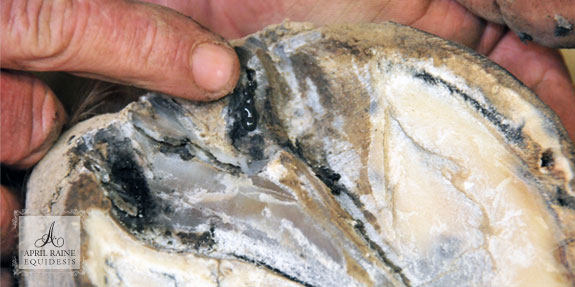KNOW YOUR SOURCES
I‘ll keep writing and adding materials to this section, so check back often, and don't hesitate to drop me a note if you're interested in a particular topic. If you find any of these pieces worth printing and sharing, please be kind enough to leave my name attached.
If you have questions, please contact me at:
765.491.2414
thrush
For years, it was thought to be a fungal disease, but modern science has cleared that up, and we now know that the thrush we find in horses' hooves is bacterial. In fact, we know that it's an anaerobic bacteria, fusobacterium necrophorum , which is present in all animal feces and most soil samples.
When it sets up residence in the horse's hoof, it generally localizes in the frog and is usually most prevalent in the collateral sulci (or commissures) and/or in the central sulcus. As an anaerobic bacteria, it thrives in a moist, dark, poorly oxygenated environment. Once it's established, you can recognize its presence from many symptoms typically associated with thrush infections:
• Repulsive odor
• Watery or oily discharge—often black in color
• Tenderness in the frog region
• Fissures / Deep pockets extending to the heel bulbs
• Loss of frog shape / integrity
Standard texts on equine health will tell you that horses develop thrush because they're being kept in a sub-standard environment. And there's no doubt that poor conditions, especially wet conditions, will promote the problem. But professional farriers will tell you that it's a more complicated issue that simply can't be explained away by pointing at dirty stalls and mud puddles.
They'll tell you they've seen horses with thrush in some awfully clean, pristine barns. Likewise, they'll tell you they've seen feedlot horses with no thrush despite their living fetlock deep in manure and mud. So keep a clean stall, but realize that prevention involves more than simply providing a clean / dry environment. It also involves performing regular maintenance to maintain the hoof capsule in a balanced, supportive manner, and allowing the horse to get sufficient activity and/or exercise.
In fact, one of the most important factors in avoiding and/or eliminating thrush is exercise. Those feedlot horses are working hard all day, getting a lot of activity and moving in a natural manner that promotes good vascularity in the foot. The horses standing in those pristine stalls are simply standing, so they are not promoting the same kind of vascularity to generate a good healthy foot.
Likewise, the horse that is receiving regular maintenance from a professional farrier will maintain a more balanced and supportive hoof. And that balance lends itself to even loading, compression, and concussion, all of which promotes good vascularity and overall health.
If you're too late for prevention and need to be worrying about treatment, it will vary according to the severity of the condition. Should the thrush be advanced to the point that the horse is lame, blood is present, and/or puss or proud flesh is present, an equine veterinarian should be contacted to debride the infected area and administer appropriate medications and possibly a tetanus vaccine or booster.
Cases of a more intermediate nature (i.e., ones which are not invasive of sensitive tissue), should be debrided and treated aggressively with commercially available medications. While home remedies and recipes abound, many are simply inappropriate. For instance, you will find texts advocating the use of bleach on thrush. The authors of these treatises would likely never pour bleach on an open wound of the hip, yet they willingly recommend that you soak an open hoof wound and its exposed sensitive tissue in bleach. You're much better off to use mild disinfectants and hoof packing!
Ultimately, you need to have your horse trimmed or shod properly from the beginning, make sure he gets plenty of exercise, and keep on top of maintenance, including regular hoof care and a good environment. Horses especially need lots of exercise; those that stand in stalls are more prone to thrush, which is likely more related to the standing than it is to what they're standing in.








